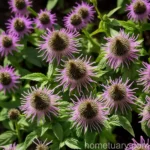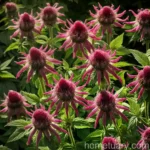Dotted Beebalm (Monarda punctata ‘Fantasy’): A Comprehensive Care Guide
Dotted beebalm, scientifically known as Monarda punctata ‘Fantasy,’ is a stunning perennial herbaceous plant that belongs to the mint family, Lamiaceae. This native American species is valued for its unique dotted tubular flowers and aromatic foliage. In this comprehensive care guide, we will explore the cultural significance, uses, cultivation requirements, and maintenance tips for the dotted beebalm plant.
What is Dotted Beebalm (Monarda punctata ‘Fantasy’)?
Dotted beebalm, Monarda punctata ‘Fantasy,’ is a visually striking plant that thrives in warm, sunny habitats, particularly in the eastern and central regions of the United States. It is characterized by its distinctive whorls of tubular, pale pink to lavender flowers, each adorned with dark purple spots. The dainty blossoms are set against a backdrop of lance-shaped, aromatic leaves, which emit a pleasant minty fragrance when crushed. This perennial plant typically reaches a height of 24 to 36 inches and spreads vigorously, making it an excellent choice for naturalistic or wildflower gardens.
Key Takeaways – Dotted Beebalm (Monarda punctata ‘Fantasy’)
- Dotted Beebalm Plant
- Native perennial herbaceous plant with unique dotted tubular flowers and aromatic foliage.
- Monarda punctata ‘Fantasy’ Care
- Requires well-drained soil, ample sunlight, and moderate watering. Pruning and deadheading help maintain its shape and encourage continuous blooming.
- Growing Dotted Beebalm
- Thrives in warm, sunny climates and well-drained, slightly acidic soil. Regular watering is essential, particularly during dry spells.
- Monarda punctata ‘Fantasy’ Varieties
- ‘Fantasy’ is a cultivated variety, valued for its distinct lavender blooms adorned with dark purple spots.
- Dotted Beebalm Characteristics
- Notable for its whorls of tubular, pale pink to lavender flowers and aromatic, lance-shaped leaves.
- Monarda punctata ‘Fantasy’ Flowers
- Displays beautiful spotted, tubular flowers in shades of pale pink and lavender, attracting pollinators with its nectar-rich blooms.
Culture
Uses
The dotted beebalm plant is renowned for its ecological and horticultural uses:
-
Ecological Importance: As a native plant, dotted beebalm contributes to the conservation and restoration of local ecosystems, providing nectar for pollinators like butterflies, bees, and hummingbirds. The aromatic foliage also deters browsing by deer and rabbits, making it a valuable addition to wildlife-friendly gardens.
-
Ornamental Value: In horticulture, Monarda punctata ‘Fantasy’ is prized for its aesthetic appeal, enhancing perennial borders, cottage gardens, and naturalistic landscapes. Additionally, its herbal and medicinal properties add further value to this versatile plant.
Water
Proper watering is crucial for the health and vigor of dotted beebalm. While the plant exhibits good drought tolerance once established, consistent moisture is essential, especially during the hot summer months. Adequate hydration supports robust growth and prolific flowering, preventing the development of stress-related issues and ensuring the plant’s long-term vitality.
- Water Needs: Maintain moderately moist soil; provide supplemental watering during prolonged dry periods.
- Seasonal Considerations: Adjust watering frequency based on the plant’s growth stage and prevailing weather conditions. Water more frequently during periods of active growth and blooming.
Sunlight
Dotted beebalm thrives in bright, sunny locations and thrives under full sun exposure. Adequate sunlight is vital for promoting healthy growth, abundant flowering, and the development of its characteristic aromatic foliage.
- Sun Exposure: Plant in an area that receives at least six to eight hours of direct sunlight daily for optimal performance.
- Shade Tolerance: While it prefers full sun, dotted beebalm can tolerate partial shade, particularly in regions with intense afternoon sun or during periods of extreme heat.
Fertilizer
Fertilization plays a significant role in nourishing and sustaining the robust growth and floriferous nature of dotted beebalm. Applying a balanced, slow-release fertilizer at the appropriate times can provide the necessary nutrients for vigorous flowering and overall plant health.
- Fertilization Schedule: Apply a balanced fertilizer in early spring as new growth emerges, following the manufacturer’s recommended application rates.
- Special Considerations: Avoid excessive use of high-nitrogen fertilizers, as this may promote lush foliage at the expense of flowering.
Soil
The choice of soil type and quality significantly impacts the growth, vitality, and flowering performance of Monarda punctata ‘Fantasy.’ Providing the appropriate soil conditions ensures optimal root development, nutrient uptake, and resistance to soil-borne diseases.
- Soil Type: Plant in well-draining, loamy soil with a slightly acidic to neutral pH (6.0 – 7.0).
- Soil Amendments: Incorporate organic matter, such as compost or well-rotted manure, during planting to enhance soil structure and fertility.
Pruning
Regular maintenance, including proper pruning and deadheading, is essential for preserving the attractive appearance and prolonged flowering of dotted beebalm. By removing spent blooms and controlling excessive growth, gardeners can encourage continuous blooming and prevent self-seeding.
- Deadheading: Remove faded flowers promptly to stimulate the production of new blooms and prevent the formation of seed heads.
- Pruning Techniques: Cut back the entire plant by a third to half in late spring to encourage branching and compact growth. Conduct further pruning as needed to control its exuberant spreading habit.
Propagation
The propagation of dotted beebalm allows for the expansion of its presence in gardens and landscapes, facilitating the preservation and dissemination of this valuable plant species. Understanding the various propagation methods contributes to the successful cultivation and availability of Monarda punctata ‘Fantasy.’
-
Propagation Methods: Dotted beebalm can be propagated through division, stem cuttings, or seed sowing. Each method offers distinct advantages and may be selected based on the desired scale and speed of propagation.
-
Division: In early spring, lift and divide established clumps, ensuring that each division contains well-developed roots and shoots.
-
Stem Cuttings: Propagate new plants from terminal stem cuttings taken in early summer, using a rooting hormone to promote successful establishment.
-
Seed Propagation: Sow ripe seeds in containers or directly in the garden soil, as viable seeds will readily germinate under favorable conditions.
Container Popularity
Dotted beebalm is also well-suited for container gardening, providing an opportunity to enjoy its charm and fragrance in confined spaces such as patios, balconies, and small urban gardens. When grown in containers, the plant’s adaptability and portability enable it to thrive in various settings, from traditional garden pots to decorative planters.
-
Container Selection: Choose a spacious container with adequate drainage holes to accommodate the plant’s root system and ensure proper aeration.
-
Growing Medium: Utilize a high-quality potting mix formulated for perennial plants, enriched with organic matter to promote healthy growth and moisture retention.
Common Diseases
Like other plants, dotted beebalm is susceptible to certain diseases that can compromise its health and appearance. Recognizing and promptly addressing common diseases is essential for effective disease management and the preservation of the plant’s vitality.
Disease Diagnosis
-
Powdery Mildew: A common fungal disease that presents as a powdery, white coating on the foliage, resulting in stunted growth and reduced flowering. Provide proper air circulation and, if necessary, apply fungicidal treatments to control the spread of the disease.
-
Leaf Spot: Manifested as dark, water-soaked lesions on the leaves, leaf spot diseases can be controlled through sanitation, adequate spacing, and the removal of affected plant material.
Common Pests
In addition to diseases, various pests can pose a threat to the well-being of dotted beebalm. Implementing integrated pest management strategies can effectively minimize pest damage and ensure the plant’s continued vigor.
-
Aphids: These small, sap-sucking insects can distort new growth and excrete honeydew, leading to the development of sooty mold. Use insecticidal soap or horticultural oil to manage infestations, promoting natural predators for long-term control.
-
Spider Mites: Infestations by spider mites can cause stippled, discolored foliage and a decline in plant health. Maintain adequate moisture levels and use miticides if necessary to manage these pests.
Botanist’s Tips
-
Companion Planting: Pair dotted beebalm with compatible companions such as coneflowers (Echinacea), black-eyed Susans (Rudbeckia), and native grasses to create aesthetically pleasing and ecologically beneficial plant communities.
-
Wildlife Habitat: In addition to attracting pollinators, dotted beebalm serves as a valuable habitat plant for beneficial insects, supporting a diverse array of wildlife within the garden.
Fun Facts
- Dotted beebalm (Monarda punctata ‘Fantasy’) is commonly referred to as “spotted beebalm” due to its unique spotted flowers, which attract pollinators with their abundant nectar.
- The aromatic foliage of dotted beebalm can be utilized in herbal preparations, such as teas and potpourri, infusing the air with a refreshing, minty scent.
- The flowers of Monarda punctata ‘Fantasy’ are adored by butterflies, making it a delightful addition to butterfly gardens and wildlife-friendly landscapes.
Links to External Resources
For additional information on growing and caring for dotted beebalm (Monarda punctata ‘Fantasy’), I recommend exploring the following resources:
- The American Horticultural Society
- The National Gardening Association
- The University Extension Services
- Royal Horticultural Society
- The North American Native Plant Society
In summary, the cultivation and maintenance of dotted beebalm, Monarda punctata ‘Fantasy’, offer a rewarding experience for gardeners and plant enthusiasts. Its ecological significance, ornamental value, and diverse uses underscore its importance in sustainable landscapes and gardens. By embracing the unique qualities of this native perennial, gardeners can contribute to the conservation of native flora and create vibrant, biodiverse habitats that support wildlife and enhance the beauty of outdoor spaces.
Remember to always consult local gardening experts and reputable sources for specific cultivation advice tailored to your region, as environmental factors and growing conditions can vary significantly across different geographic locations. With proper care and appreciation for its unique attributes, dotted beebalm will grace the garden with its distinctive beauty, enriching the natural environment and delighting observers with its charming floral display.















